CPCCBC5003A: Supervise Planning of Medium Rise Building Project
VerifiedAdded on 2023/03/31
|13
|2422
|360
Report
AI Summary
This report provides a comprehensive review of construction practices and procedures for a commercial building project with a minimum gross floor area of 1,000 m2 and a height not exceeding three stories. It covers various aspects including construction industry contracts such as lump-sum, unit price, cost-plus, guaranteed maximum price, and time and materials contracts. The report also delves into the construction industry subcontracting system, documents required for a complete contract package, methods for calculating material quantities and labor hours, the industrial relations system involving organizations like the Master Builders Association and CFMEU, and the importance of enterprise agreements. Furthermore, it outlines the licensing requirements for commercial builders, plant operators, electricians, plumbers, architects, and building surveyors. The report also addresses state government legislation, building standards and codes relevant to medium-rise building projects, and key sections of the OHS Act 2004 pertaining to workplace safety, including the duties of employers, suppliers, and employees.
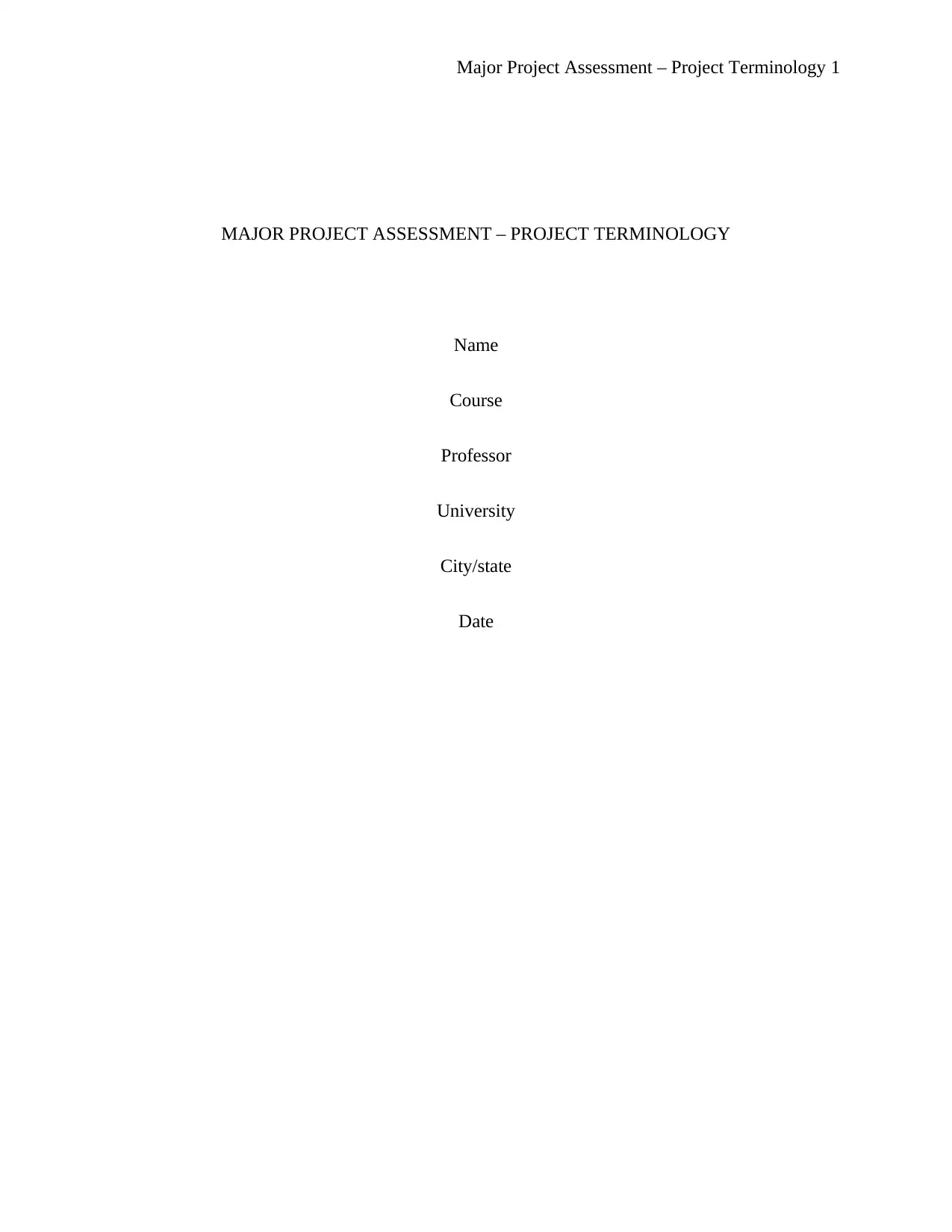
Major Project Assessment – Project Terminology 1
MAJOR PROJECT ASSESSMENT – PROJECT TERMINOLOGY
Name
Course
Professor
University
City/state
Date
MAJOR PROJECT ASSESSMENT – PROJECT TERMINOLOGY
Name
Course
Professor
University
City/state
Date
Paraphrase This Document
Need a fresh take? Get an instant paraphrase of this document with our AI Paraphraser
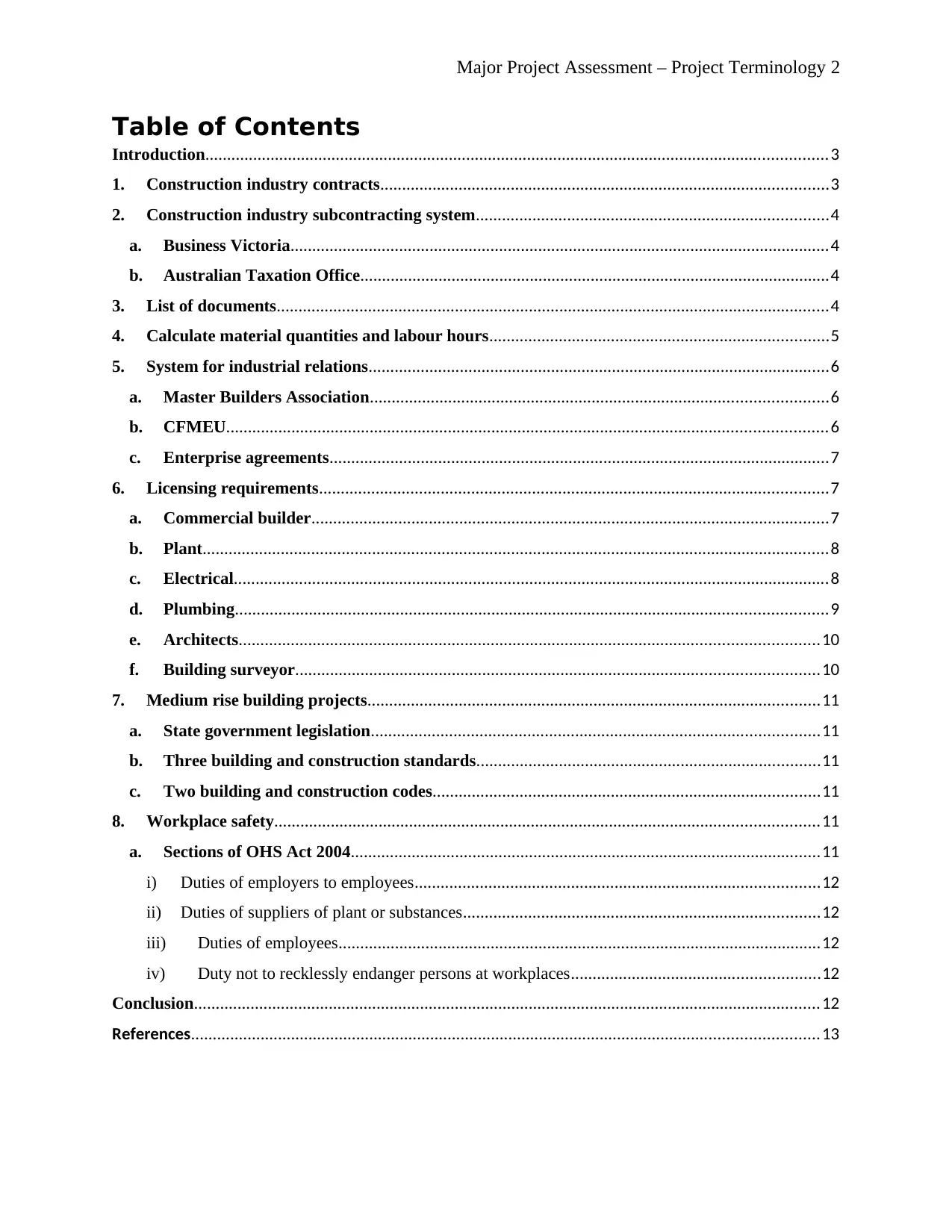
Major Project Assessment – Project Terminology 2
Table of Contents
Introduction...............................................................................................................................................3
1. Construction industry contracts.......................................................................................................3
2. Construction industry subcontracting system.................................................................................4
a. Business Victoria............................................................................................................................4
b. Australian Taxation Office............................................................................................................4
3. List of documents...............................................................................................................................4
4. Calculate material quantities and labour hours..............................................................................5
5. System for industrial relations..........................................................................................................6
a. Master Builders Association.........................................................................................................6
b. CFMEU..........................................................................................................................................6
c. Enterprise agreements...................................................................................................................7
6. Licensing requirements.....................................................................................................................7
a. Commercial builder.......................................................................................................................7
b. Plant................................................................................................................................................8
c. Electrical.........................................................................................................................................8
d. Plumbing........................................................................................................................................9
e. Architects.....................................................................................................................................10
f. Building surveyor........................................................................................................................10
7. Medium rise building projects........................................................................................................11
a. State government legislation.......................................................................................................11
b. Three building and construction standards...............................................................................11
c. Two building and construction codes.........................................................................................11
8. Workplace safety.............................................................................................................................11
a. Sections of OHS Act 2004............................................................................................................11
i) Duties of employers to employees.............................................................................................12
ii) Duties of suppliers of plant or substances..................................................................................12
iii) Duties of employees...............................................................................................................12
iv) Duty not to recklessly endanger persons at workplaces.........................................................12
Conclusion................................................................................................................................................12
References................................................................................................................................................13
Table of Contents
Introduction...............................................................................................................................................3
1. Construction industry contracts.......................................................................................................3
2. Construction industry subcontracting system.................................................................................4
a. Business Victoria............................................................................................................................4
b. Australian Taxation Office............................................................................................................4
3. List of documents...............................................................................................................................4
4. Calculate material quantities and labour hours..............................................................................5
5. System for industrial relations..........................................................................................................6
a. Master Builders Association.........................................................................................................6
b. CFMEU..........................................................................................................................................6
c. Enterprise agreements...................................................................................................................7
6. Licensing requirements.....................................................................................................................7
a. Commercial builder.......................................................................................................................7
b. Plant................................................................................................................................................8
c. Electrical.........................................................................................................................................8
d. Plumbing........................................................................................................................................9
e. Architects.....................................................................................................................................10
f. Building surveyor........................................................................................................................10
7. Medium rise building projects........................................................................................................11
a. State government legislation.......................................................................................................11
b. Three building and construction standards...............................................................................11
c. Two building and construction codes.........................................................................................11
8. Workplace safety.............................................................................................................................11
a. Sections of OHS Act 2004............................................................................................................11
i) Duties of employers to employees.............................................................................................12
ii) Duties of suppliers of plant or substances..................................................................................12
iii) Duties of employees...............................................................................................................12
iv) Duty not to recklessly endanger persons at workplaces.........................................................12
Conclusion................................................................................................................................................12
References................................................................................................................................................13
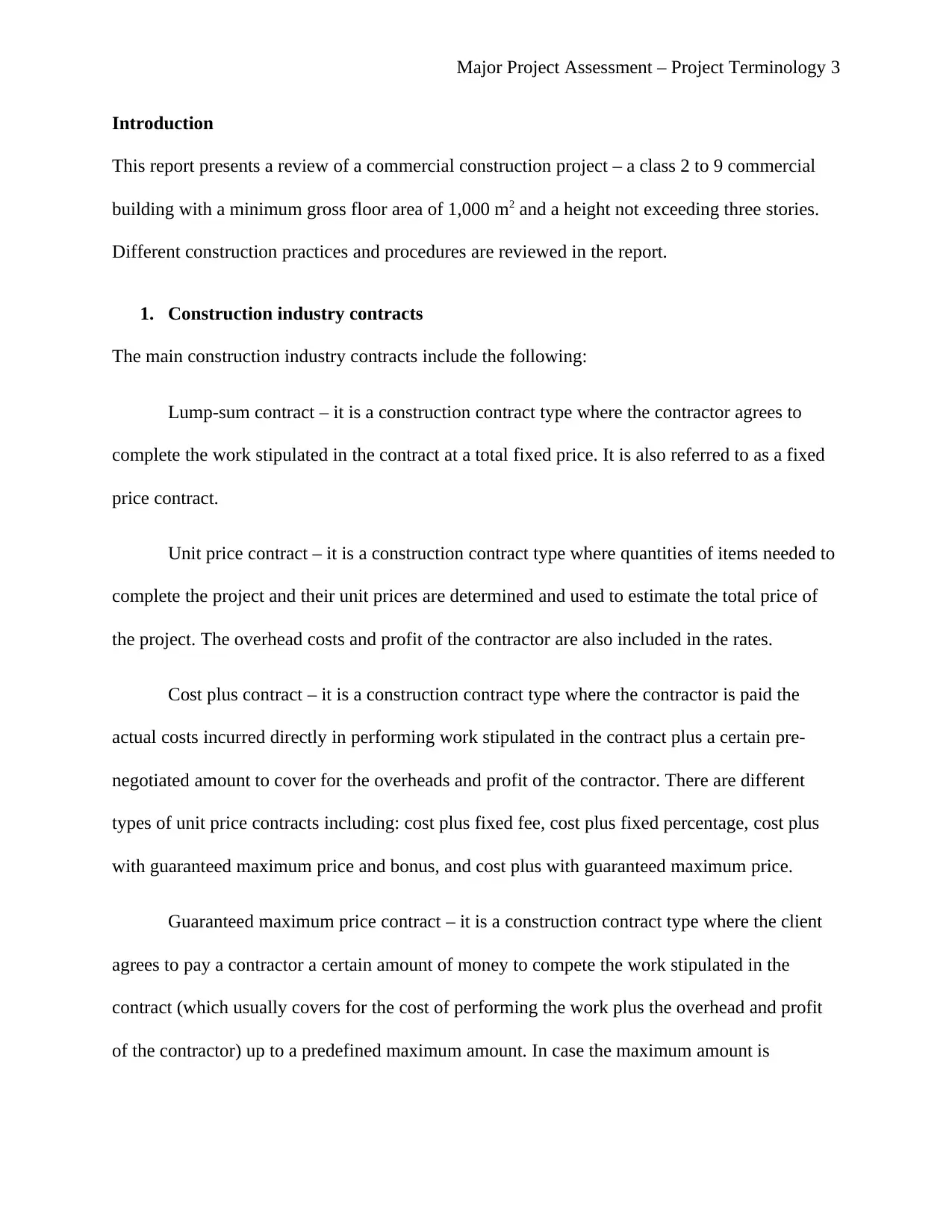
Major Project Assessment – Project Terminology 3
Introduction
This report presents a review of a commercial construction project – a class 2 to 9 commercial
building with a minimum gross floor area of 1,000 m2 and a height not exceeding three stories.
Different construction practices and procedures are reviewed in the report.
1. Construction industry contracts
The main construction industry contracts include the following:
Lump-sum contract – it is a construction contract type where the contractor agrees to
complete the work stipulated in the contract at a total fixed price. It is also referred to as a fixed
price contract.
Unit price contract – it is a construction contract type where quantities of items needed to
complete the project and their unit prices are determined and used to estimate the total price of
the project. The overhead costs and profit of the contractor are also included in the rates.
Cost plus contract – it is a construction contract type where the contractor is paid the
actual costs incurred directly in performing work stipulated in the contract plus a certain pre-
negotiated amount to cover for the overheads and profit of the contractor. There are different
types of unit price contracts including: cost plus fixed fee, cost plus fixed percentage, cost plus
with guaranteed maximum price and bonus, and cost plus with guaranteed maximum price.
Guaranteed maximum price contract – it is a construction contract type where the client
agrees to pay a contractor a certain amount of money to compete the work stipulated in the
contract (which usually covers for the cost of performing the work plus the overhead and profit
of the contractor) up to a predefined maximum amount. In case the maximum amount is
Introduction
This report presents a review of a commercial construction project – a class 2 to 9 commercial
building with a minimum gross floor area of 1,000 m2 and a height not exceeding three stories.
Different construction practices and procedures are reviewed in the report.
1. Construction industry contracts
The main construction industry contracts include the following:
Lump-sum contract – it is a construction contract type where the contractor agrees to
complete the work stipulated in the contract at a total fixed price. It is also referred to as a fixed
price contract.
Unit price contract – it is a construction contract type where quantities of items needed to
complete the project and their unit prices are determined and used to estimate the total price of
the project. The overhead costs and profit of the contractor are also included in the rates.
Cost plus contract – it is a construction contract type where the contractor is paid the
actual costs incurred directly in performing work stipulated in the contract plus a certain pre-
negotiated amount to cover for the overheads and profit of the contractor. There are different
types of unit price contracts including: cost plus fixed fee, cost plus fixed percentage, cost plus
with guaranteed maximum price and bonus, and cost plus with guaranteed maximum price.
Guaranteed maximum price contract – it is a construction contract type where the client
agrees to pay a contractor a certain amount of money to compete the work stipulated in the
contract (which usually covers for the cost of performing the work plus the overhead and profit
of the contractor) up to a predefined maximum amount. In case the maximum amount is
⊘ This is a preview!⊘
Do you want full access?
Subscribe today to unlock all pages.

Trusted by 1+ million students worldwide
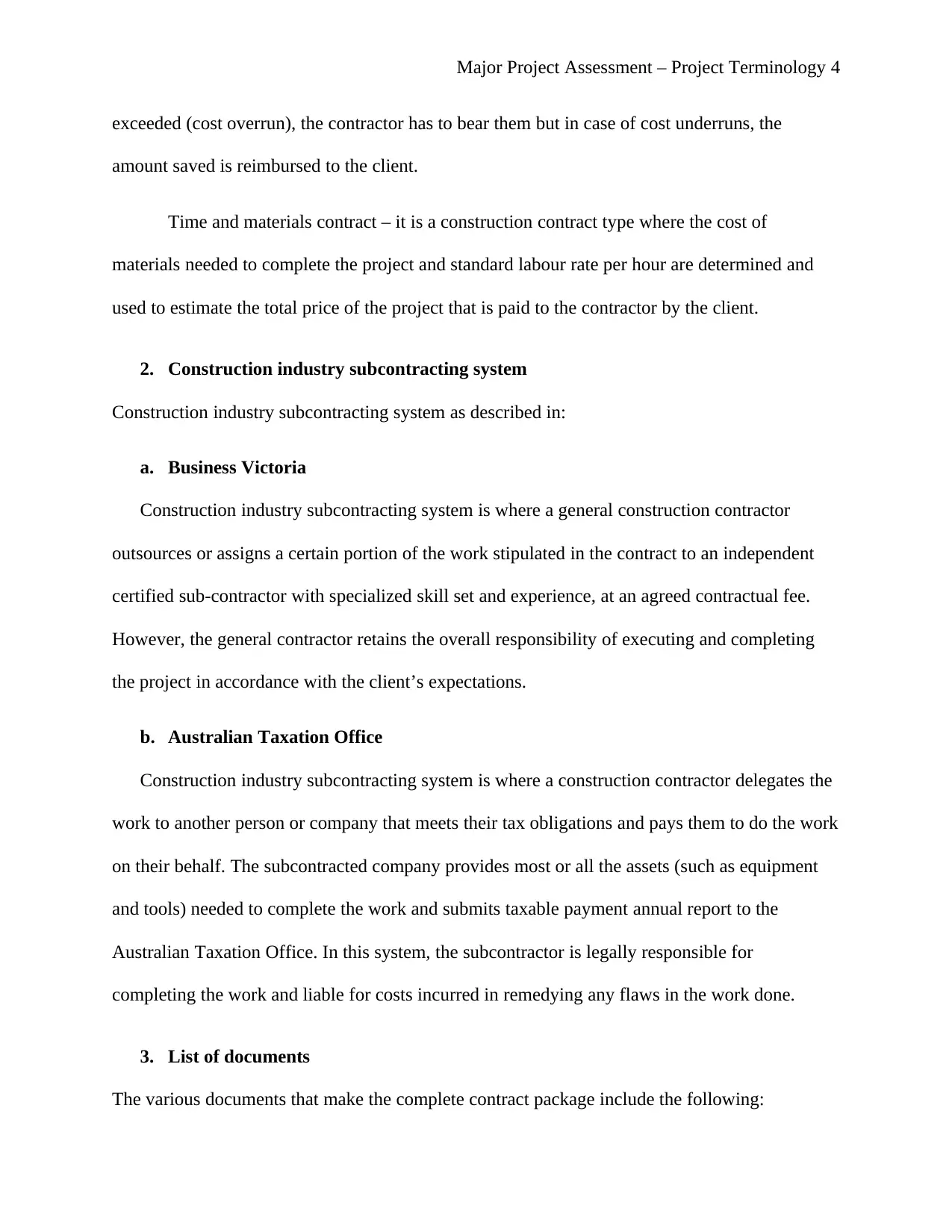
Major Project Assessment – Project Terminology 4
exceeded (cost overrun), the contractor has to bear them but in case of cost underruns, the
amount saved is reimbursed to the client.
Time and materials contract – it is a construction contract type where the cost of
materials needed to complete the project and standard labour rate per hour are determined and
used to estimate the total price of the project that is paid to the contractor by the client.
2. Construction industry subcontracting system
Construction industry subcontracting system as described in:
a. Business Victoria
Construction industry subcontracting system is where a general construction contractor
outsources or assigns a certain portion of the work stipulated in the contract to an independent
certified sub-contractor with specialized skill set and experience, at an agreed contractual fee.
However, the general contractor retains the overall responsibility of executing and completing
the project in accordance with the client’s expectations.
b. Australian Taxation Office
Construction industry subcontracting system is where a construction contractor delegates the
work to another person or company that meets their tax obligations and pays them to do the work
on their behalf. The subcontracted company provides most or all the assets (such as equipment
and tools) needed to complete the work and submits taxable payment annual report to the
Australian Taxation Office. In this system, the subcontractor is legally responsible for
completing the work and liable for costs incurred in remedying any flaws in the work done.
3. List of documents
The various documents that make the complete contract package include the following:
exceeded (cost overrun), the contractor has to bear them but in case of cost underruns, the
amount saved is reimbursed to the client.
Time and materials contract – it is a construction contract type where the cost of
materials needed to complete the project and standard labour rate per hour are determined and
used to estimate the total price of the project that is paid to the contractor by the client.
2. Construction industry subcontracting system
Construction industry subcontracting system as described in:
a. Business Victoria
Construction industry subcontracting system is where a general construction contractor
outsources or assigns a certain portion of the work stipulated in the contract to an independent
certified sub-contractor with specialized skill set and experience, at an agreed contractual fee.
However, the general contractor retains the overall responsibility of executing and completing
the project in accordance with the client’s expectations.
b. Australian Taxation Office
Construction industry subcontracting system is where a construction contractor delegates the
work to another person or company that meets their tax obligations and pays them to do the work
on their behalf. The subcontracted company provides most or all the assets (such as equipment
and tools) needed to complete the work and submits taxable payment annual report to the
Australian Taxation Office. In this system, the subcontractor is legally responsible for
completing the work and liable for costs incurred in remedying any flaws in the work done.
3. List of documents
The various documents that make the complete contract package include the following:
Paraphrase This Document
Need a fresh take? Get an instant paraphrase of this document with our AI Paraphraser
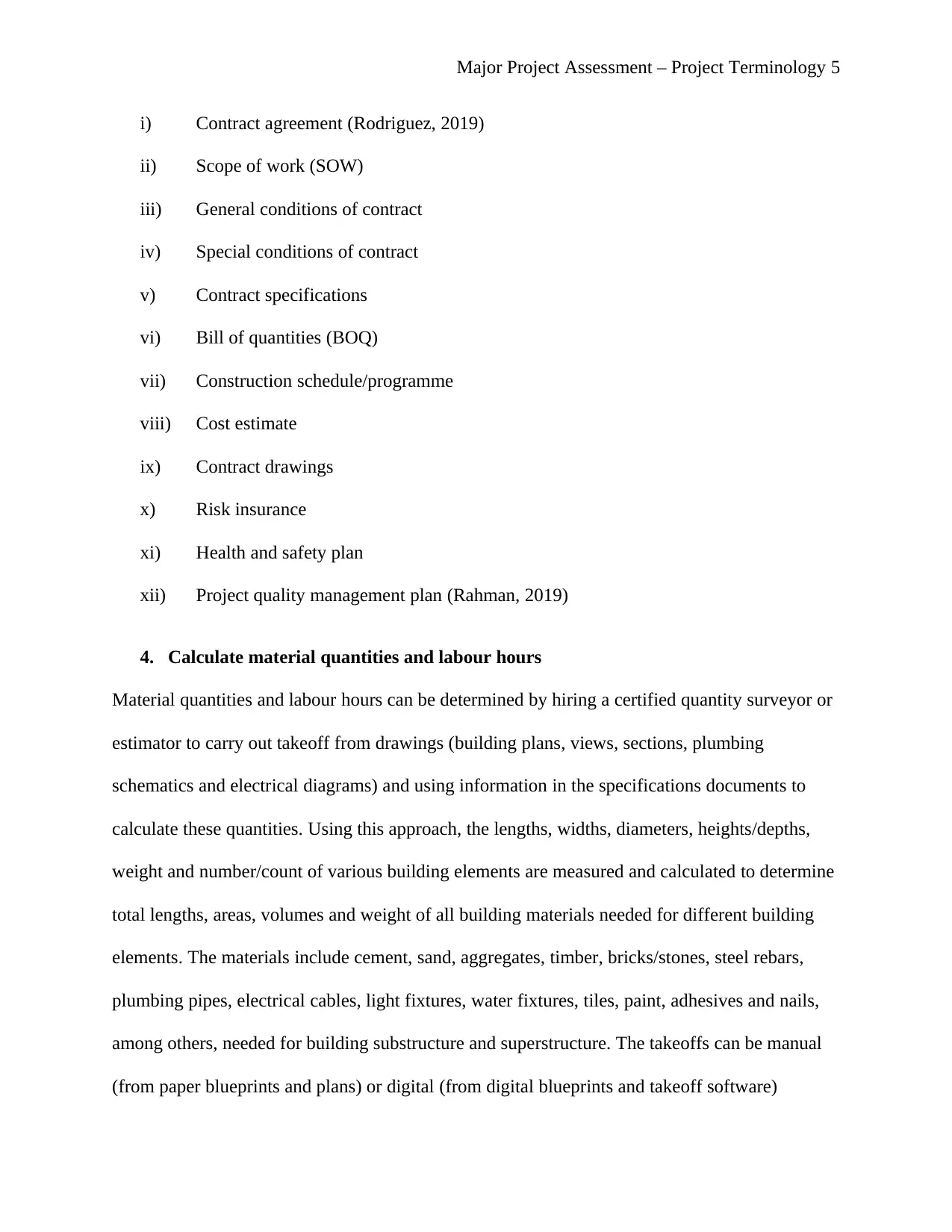
Major Project Assessment – Project Terminology 5
i) Contract agreement (Rodriguez, 2019)
ii) Scope of work (SOW)
iii) General conditions of contract
iv) Special conditions of contract
v) Contract specifications
vi) Bill of quantities (BOQ)
vii) Construction schedule/programme
viii) Cost estimate
ix) Contract drawings
x) Risk insurance
xi) Health and safety plan
xii) Project quality management plan (Rahman, 2019)
4. Calculate material quantities and labour hours
Material quantities and labour hours can be determined by hiring a certified quantity surveyor or
estimator to carry out takeoff from drawings (building plans, views, sections, plumbing
schematics and electrical diagrams) and using information in the specifications documents to
calculate these quantities. Using this approach, the lengths, widths, diameters, heights/depths,
weight and number/count of various building elements are measured and calculated to determine
total lengths, areas, volumes and weight of all building materials needed for different building
elements. The materials include cement, sand, aggregates, timber, bricks/stones, steel rebars,
plumbing pipes, electrical cables, light fixtures, water fixtures, tiles, paint, adhesives and nails,
among others, needed for building substructure and superstructure. The takeoffs can be manual
(from paper blueprints and plans) or digital (from digital blueprints and takeoff software)
i) Contract agreement (Rodriguez, 2019)
ii) Scope of work (SOW)
iii) General conditions of contract
iv) Special conditions of contract
v) Contract specifications
vi) Bill of quantities (BOQ)
vii) Construction schedule/programme
viii) Cost estimate
ix) Contract drawings
x) Risk insurance
xi) Health and safety plan
xii) Project quality management plan (Rahman, 2019)
4. Calculate material quantities and labour hours
Material quantities and labour hours can be determined by hiring a certified quantity surveyor or
estimator to carry out takeoff from drawings (building plans, views, sections, plumbing
schematics and electrical diagrams) and using information in the specifications documents to
calculate these quantities. Using this approach, the lengths, widths, diameters, heights/depths,
weight and number/count of various building elements are measured and calculated to determine
total lengths, areas, volumes and weight of all building materials needed for different building
elements. The materials include cement, sand, aggregates, timber, bricks/stones, steel rebars,
plumbing pipes, electrical cables, light fixtures, water fixtures, tiles, paint, adhesives and nails,
among others, needed for building substructure and superstructure. The takeoffs can be manual
(from paper blueprints and plans) or digital (from digital blueprints and takeoff software)
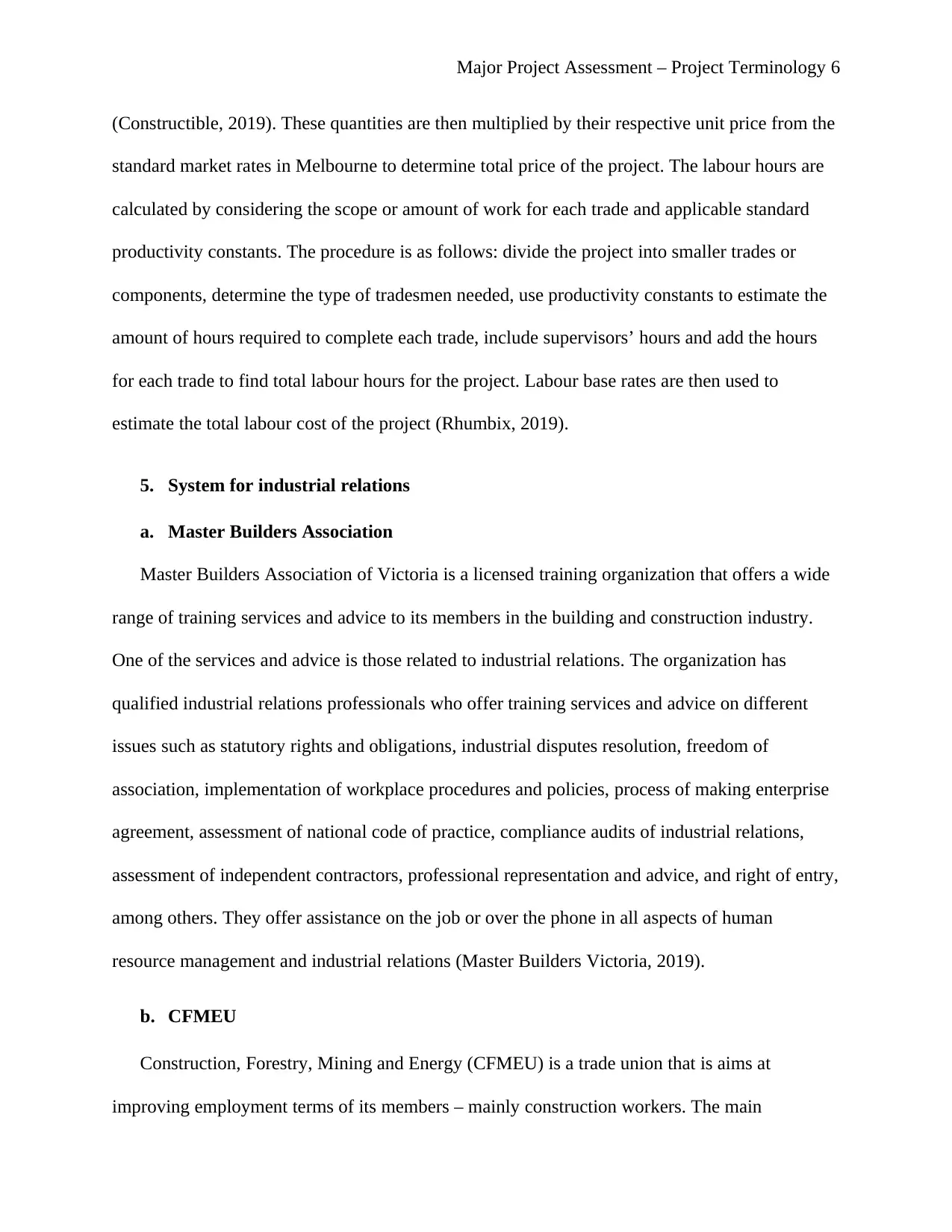
Major Project Assessment – Project Terminology 6
(Constructible, 2019). These quantities are then multiplied by their respective unit price from the
standard market rates in Melbourne to determine total price of the project. The labour hours are
calculated by considering the scope or amount of work for each trade and applicable standard
productivity constants. The procedure is as follows: divide the project into smaller trades or
components, determine the type of tradesmen needed, use productivity constants to estimate the
amount of hours required to complete each trade, include supervisors’ hours and add the hours
for each trade to find total labour hours for the project. Labour base rates are then used to
estimate the total labour cost of the project (Rhumbix, 2019).
5. System for industrial relations
a. Master Builders Association
Master Builders Association of Victoria is a licensed training organization that offers a wide
range of training services and advice to its members in the building and construction industry.
One of the services and advice is those related to industrial relations. The organization has
qualified industrial relations professionals who offer training services and advice on different
issues such as statutory rights and obligations, industrial disputes resolution, freedom of
association, implementation of workplace procedures and policies, process of making enterprise
agreement, assessment of national code of practice, compliance audits of industrial relations,
assessment of independent contractors, professional representation and advice, and right of entry,
among others. They offer assistance on the job or over the phone in all aspects of human
resource management and industrial relations (Master Builders Victoria, 2019).
b. CFMEU
Construction, Forestry, Mining and Energy (CFMEU) is a trade union that is aims at
improving employment terms of its members – mainly construction workers. The main
(Constructible, 2019). These quantities are then multiplied by their respective unit price from the
standard market rates in Melbourne to determine total price of the project. The labour hours are
calculated by considering the scope or amount of work for each trade and applicable standard
productivity constants. The procedure is as follows: divide the project into smaller trades or
components, determine the type of tradesmen needed, use productivity constants to estimate the
amount of hours required to complete each trade, include supervisors’ hours and add the hours
for each trade to find total labour hours for the project. Labour base rates are then used to
estimate the total labour cost of the project (Rhumbix, 2019).
5. System for industrial relations
a. Master Builders Association
Master Builders Association of Victoria is a licensed training organization that offers a wide
range of training services and advice to its members in the building and construction industry.
One of the services and advice is those related to industrial relations. The organization has
qualified industrial relations professionals who offer training services and advice on different
issues such as statutory rights and obligations, industrial disputes resolution, freedom of
association, implementation of workplace procedures and policies, process of making enterprise
agreement, assessment of national code of practice, compliance audits of industrial relations,
assessment of independent contractors, professional representation and advice, and right of entry,
among others. They offer assistance on the job or over the phone in all aspects of human
resource management and industrial relations (Master Builders Victoria, 2019).
b. CFMEU
Construction, Forestry, Mining and Energy (CFMEU) is a trade union that is aims at
improving employment terms of its members – mainly construction workers. The main
⊘ This is a preview!⊘
Do you want full access?
Subscribe today to unlock all pages.

Trusted by 1+ million students worldwide
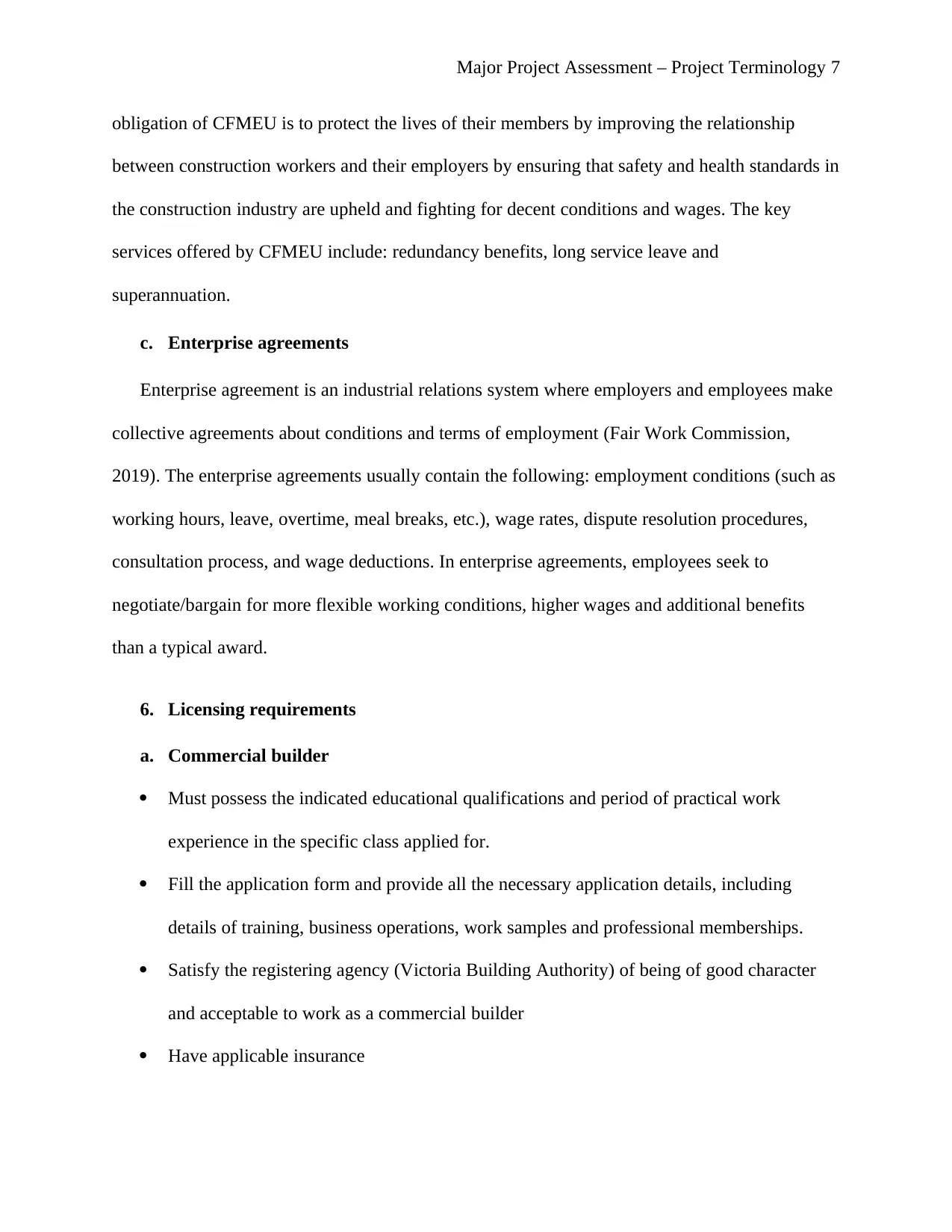
Major Project Assessment – Project Terminology 7
obligation of CFMEU is to protect the lives of their members by improving the relationship
between construction workers and their employers by ensuring that safety and health standards in
the construction industry are upheld and fighting for decent conditions and wages. The key
services offered by CFMEU include: redundancy benefits, long service leave and
superannuation.
c. Enterprise agreements
Enterprise agreement is an industrial relations system where employers and employees make
collective agreements about conditions and terms of employment (Fair Work Commission,
2019). The enterprise agreements usually contain the following: employment conditions (such as
working hours, leave, overtime, meal breaks, etc.), wage rates, dispute resolution procedures,
consultation process, and wage deductions. In enterprise agreements, employees seek to
negotiate/bargain for more flexible working conditions, higher wages and additional benefits
than a typical award.
6. Licensing requirements
a. Commercial builder
Must possess the indicated educational qualifications and period of practical work
experience in the specific class applied for.
Fill the application form and provide all the necessary application details, including
details of training, business operations, work samples and professional memberships.
Satisfy the registering agency (Victoria Building Authority) of being of good character
and acceptable to work as a commercial builder
Have applicable insurance
obligation of CFMEU is to protect the lives of their members by improving the relationship
between construction workers and their employers by ensuring that safety and health standards in
the construction industry are upheld and fighting for decent conditions and wages. The key
services offered by CFMEU include: redundancy benefits, long service leave and
superannuation.
c. Enterprise agreements
Enterprise agreement is an industrial relations system where employers and employees make
collective agreements about conditions and terms of employment (Fair Work Commission,
2019). The enterprise agreements usually contain the following: employment conditions (such as
working hours, leave, overtime, meal breaks, etc.), wage rates, dispute resolution procedures,
consultation process, and wage deductions. In enterprise agreements, employees seek to
negotiate/bargain for more flexible working conditions, higher wages and additional benefits
than a typical award.
6. Licensing requirements
a. Commercial builder
Must possess the indicated educational qualifications and period of practical work
experience in the specific class applied for.
Fill the application form and provide all the necessary application details, including
details of training, business operations, work samples and professional memberships.
Satisfy the registering agency (Victoria Building Authority) of being of good character
and acceptable to work as a commercial builder
Have applicable insurance
Paraphrase This Document
Need a fresh take? Get an instant paraphrase of this document with our AI Paraphraser

Major Project Assessment – Project Terminology 8
Provide a signed consent that allows the agency to perform a national police certificate
check
Make an application, and submit it together with supporting documents (such as ID).
Pay the application fee (Building Practitioners Board, 2019)
b. Plant
Have the specified educational qualifications and period of practical work experience in
the specific class applied for.
Background checks
Drug screening tests
Fill the application form and provide all the necessary application details, including
details of training, business operations, work samples and professional memberships.
Satisfy the registering agency of being of good character and acceptable to work as a
building surveyor
Have applicable insurance
Pay the prescribed application fee.
c. Electrical
Must possess the specified educational qualifications.
Complete the licensed electricians assessment
Possess electro-technology systems electrician certificate III
Have four years work experience as an apprentice electrician
Hold an electrician license and complete 12 months of work under supervision of an
electrician with a valid license.
Provide a signed consent that allows the agency to perform a national police certificate
check
Make an application, and submit it together with supporting documents (such as ID).
Pay the application fee (Building Practitioners Board, 2019)
b. Plant
Have the specified educational qualifications and period of practical work experience in
the specific class applied for.
Background checks
Drug screening tests
Fill the application form and provide all the necessary application details, including
details of training, business operations, work samples and professional memberships.
Satisfy the registering agency of being of good character and acceptable to work as a
building surveyor
Have applicable insurance
Pay the prescribed application fee.
c. Electrical
Must possess the specified educational qualifications.
Complete the licensed electricians assessment
Possess electro-technology systems electrician certificate III
Have four years work experience as an apprentice electrician
Hold an electrician license and complete 12 months of work under supervision of an
electrician with a valid license.
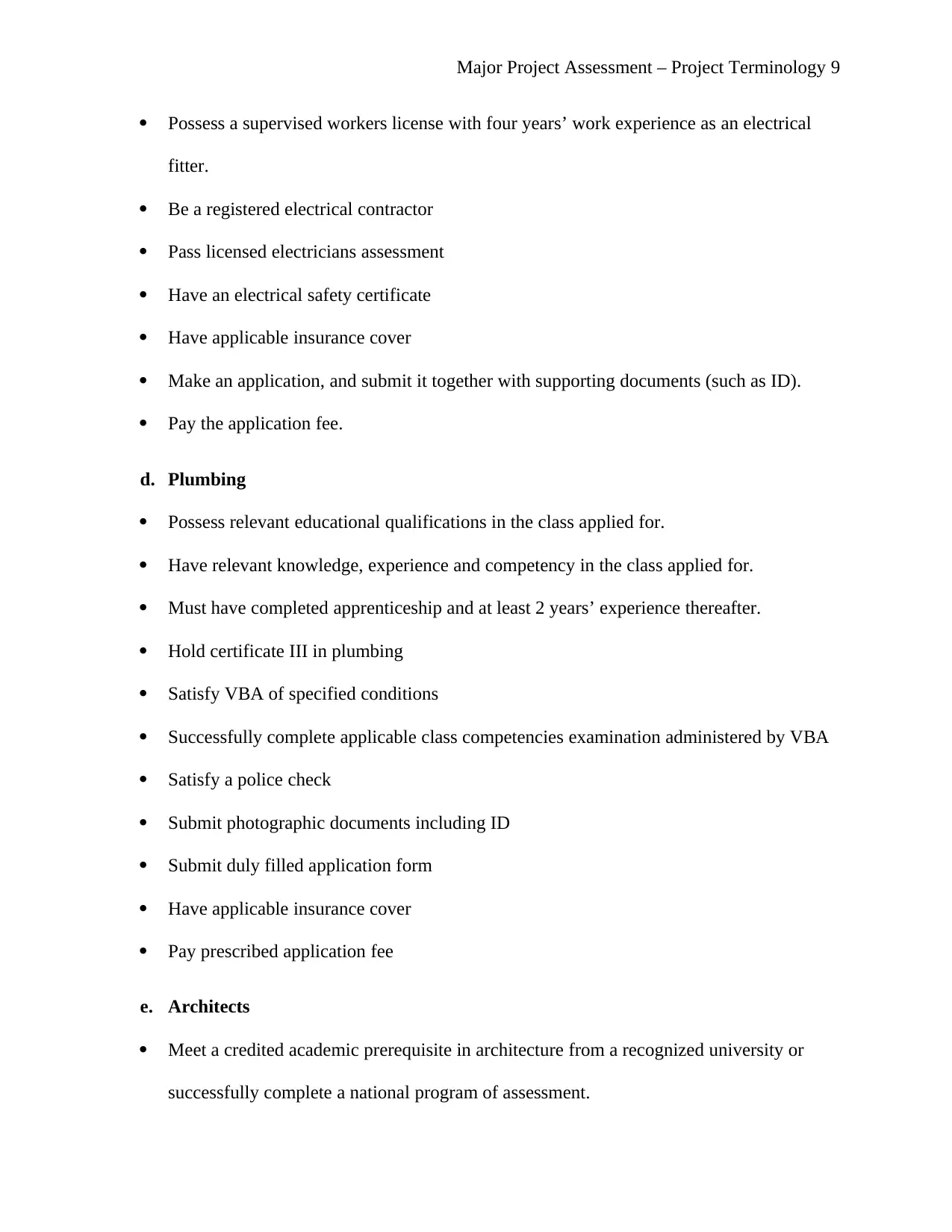
Major Project Assessment – Project Terminology 9
Possess a supervised workers license with four years’ work experience as an electrical
fitter.
Be a registered electrical contractor
Pass licensed electricians assessment
Have an electrical safety certificate
Have applicable insurance cover
Make an application, and submit it together with supporting documents (such as ID).
Pay the application fee.
d. Plumbing
Possess relevant educational qualifications in the class applied for.
Have relevant knowledge, experience and competency in the class applied for.
Must have completed apprenticeship and at least 2 years’ experience thereafter.
Hold certificate III in plumbing
Satisfy VBA of specified conditions
Successfully complete applicable class competencies examination administered by VBA
Satisfy a police check
Submit photographic documents including ID
Submit duly filled application form
Have applicable insurance cover
Pay prescribed application fee
e. Architects
Meet a credited academic prerequisite in architecture from a recognized university or
successfully complete a national program of assessment.
Possess a supervised workers license with four years’ work experience as an electrical
fitter.
Be a registered electrical contractor
Pass licensed electricians assessment
Have an electrical safety certificate
Have applicable insurance cover
Make an application, and submit it together with supporting documents (such as ID).
Pay the application fee.
d. Plumbing
Possess relevant educational qualifications in the class applied for.
Have relevant knowledge, experience and competency in the class applied for.
Must have completed apprenticeship and at least 2 years’ experience thereafter.
Hold certificate III in plumbing
Satisfy VBA of specified conditions
Successfully complete applicable class competencies examination administered by VBA
Satisfy a police check
Submit photographic documents including ID
Submit duly filled application form
Have applicable insurance cover
Pay prescribed application fee
e. Architects
Meet a credited academic prerequisite in architecture from a recognized university or
successfully complete a national program of assessment.
⊘ This is a preview!⊘
Do you want full access?
Subscribe today to unlock all pages.

Trusted by 1+ million students worldwide

Major Project Assessment – Project Terminology 10
Have at least 2 years recent work experience
Successfully complete Architectural Practice Examination (APE) of the Architects
Accreditation Council of Australia (AACA) (Architects Registration Board of Victoria ,
2019)
Have knowledge of relevant competency-based standards
Make an application, and submit it together with supporting documents (such as ID).
Pay the prescribed application fee.
f. Building surveyor
Possess the specified educational qualifications and period of practical work experience
in the specific class applied for.
Fill the application form and provide all the necessary application details, including
details of training, business operations, work samples and professional memberships.
Satisfy the registering agency of being of good character and acceptable to work as a
building surveyor
Hold relevant qualifications
Have applicable insurance
Provide a signed consent that allows the agency to perform a national police certificate
check
Make an application, and submit it together with supporting documents (such as ID).
Pay the prescribed application fee.
Have at least 2 years recent work experience
Successfully complete Architectural Practice Examination (APE) of the Architects
Accreditation Council of Australia (AACA) (Architects Registration Board of Victoria ,
2019)
Have knowledge of relevant competency-based standards
Make an application, and submit it together with supporting documents (such as ID).
Pay the prescribed application fee.
f. Building surveyor
Possess the specified educational qualifications and period of practical work experience
in the specific class applied for.
Fill the application form and provide all the necessary application details, including
details of training, business operations, work samples and professional memberships.
Satisfy the registering agency of being of good character and acceptable to work as a
building surveyor
Hold relevant qualifications
Have applicable insurance
Provide a signed consent that allows the agency to perform a national police certificate
check
Make an application, and submit it together with supporting documents (such as ID).
Pay the prescribed application fee.
Paraphrase This Document
Need a fresh take? Get an instant paraphrase of this document with our AI Paraphraser
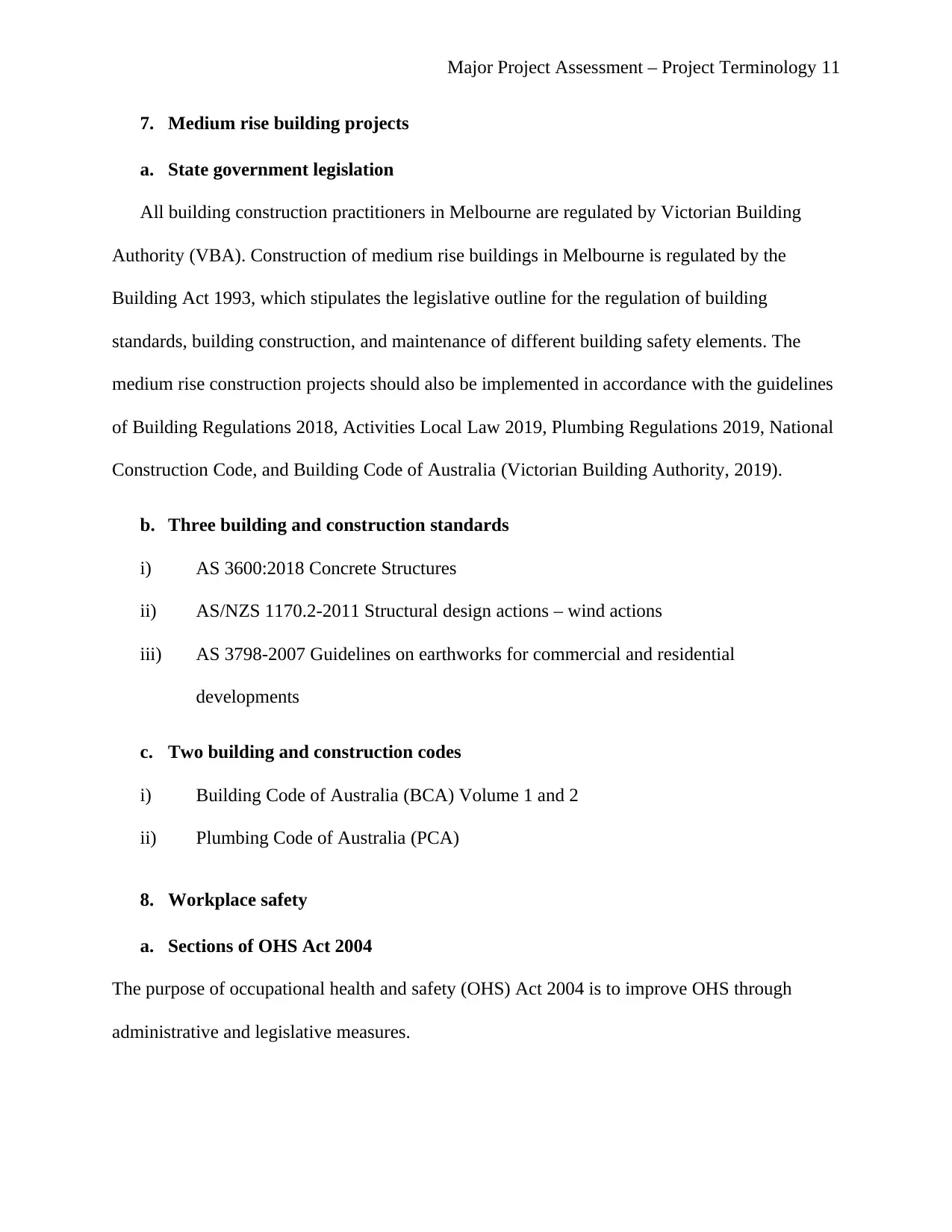
Major Project Assessment – Project Terminology 11
7. Medium rise building projects
a. State government legislation
All building construction practitioners in Melbourne are regulated by Victorian Building
Authority (VBA). Construction of medium rise buildings in Melbourne is regulated by the
Building Act 1993, which stipulates the legislative outline for the regulation of building
standards, building construction, and maintenance of different building safety elements. The
medium rise construction projects should also be implemented in accordance with the guidelines
of Building Regulations 2018, Activities Local Law 2019, Plumbing Regulations 2019, National
Construction Code, and Building Code of Australia (Victorian Building Authority, 2019).
b. Three building and construction standards
i) AS 3600:2018 Concrete Structures
ii) AS/NZS 1170.2-2011 Structural design actions – wind actions
iii) AS 3798-2007 Guidelines on earthworks for commercial and residential
developments
c. Two building and construction codes
i) Building Code of Australia (BCA) Volume 1 and 2
ii) Plumbing Code of Australia (PCA)
8. Workplace safety
a. Sections of OHS Act 2004
The purpose of occupational health and safety (OHS) Act 2004 is to improve OHS through
administrative and legislative measures.
7. Medium rise building projects
a. State government legislation
All building construction practitioners in Melbourne are regulated by Victorian Building
Authority (VBA). Construction of medium rise buildings in Melbourne is regulated by the
Building Act 1993, which stipulates the legislative outline for the regulation of building
standards, building construction, and maintenance of different building safety elements. The
medium rise construction projects should also be implemented in accordance with the guidelines
of Building Regulations 2018, Activities Local Law 2019, Plumbing Regulations 2019, National
Construction Code, and Building Code of Australia (Victorian Building Authority, 2019).
b. Three building and construction standards
i) AS 3600:2018 Concrete Structures
ii) AS/NZS 1170.2-2011 Structural design actions – wind actions
iii) AS 3798-2007 Guidelines on earthworks for commercial and residential
developments
c. Two building and construction codes
i) Building Code of Australia (BCA) Volume 1 and 2
ii) Plumbing Code of Australia (PCA)
8. Workplace safety
a. Sections of OHS Act 2004
The purpose of occupational health and safety (OHS) Act 2004 is to improve OHS through
administrative and legislative measures.
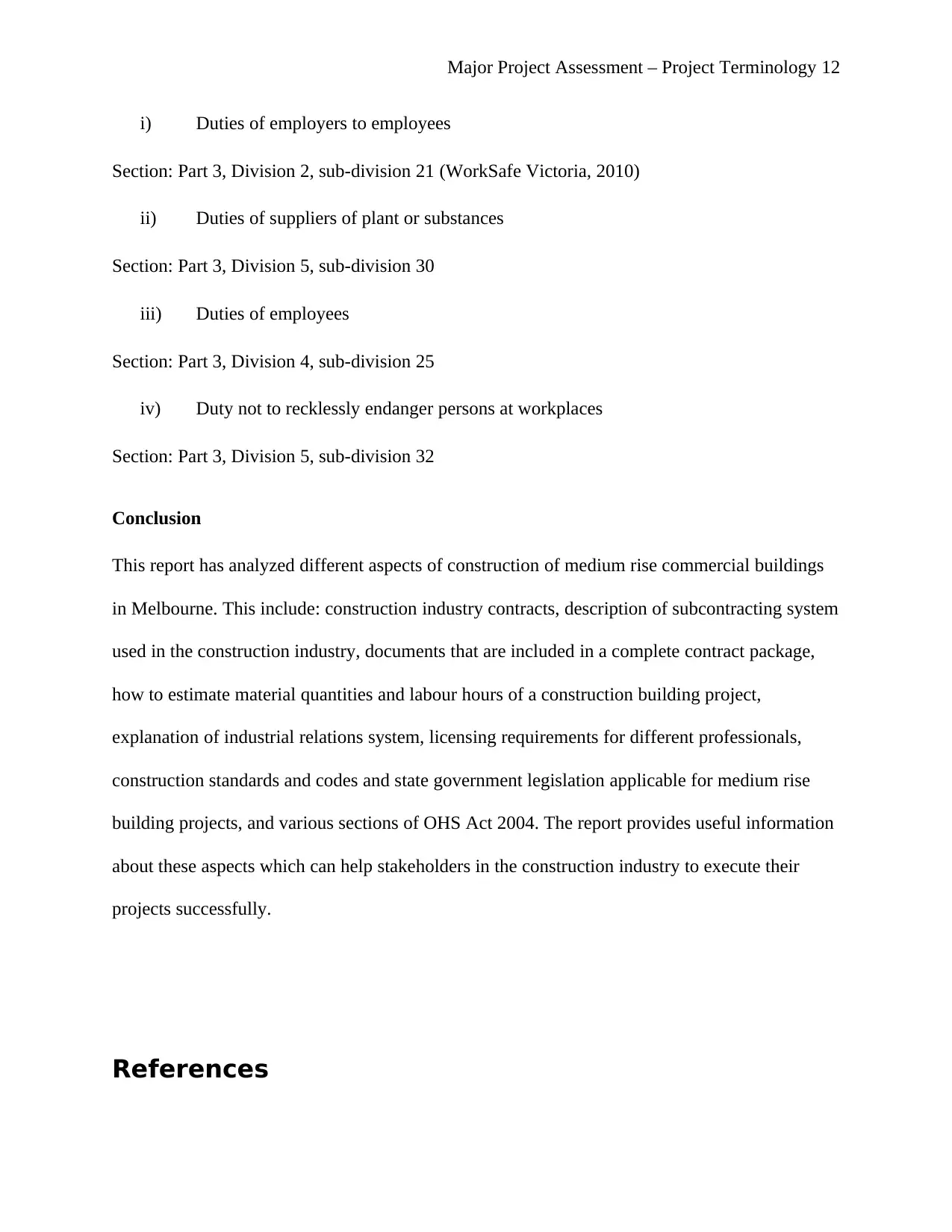
Major Project Assessment – Project Terminology 12
i) Duties of employers to employees
Section: Part 3, Division 2, sub-division 21 (WorkSafe Victoria, 2010)
ii) Duties of suppliers of plant or substances
Section: Part 3, Division 5, sub-division 30
iii) Duties of employees
Section: Part 3, Division 4, sub-division 25
iv) Duty not to recklessly endanger persons at workplaces
Section: Part 3, Division 5, sub-division 32
Conclusion
This report has analyzed different aspects of construction of medium rise commercial buildings
in Melbourne. This include: construction industry contracts, description of subcontracting system
used in the construction industry, documents that are included in a complete contract package,
how to estimate material quantities and labour hours of a construction building project,
explanation of industrial relations system, licensing requirements for different professionals,
construction standards and codes and state government legislation applicable for medium rise
building projects, and various sections of OHS Act 2004. The report provides useful information
about these aspects which can help stakeholders in the construction industry to execute their
projects successfully.
References
i) Duties of employers to employees
Section: Part 3, Division 2, sub-division 21 (WorkSafe Victoria, 2010)
ii) Duties of suppliers of plant or substances
Section: Part 3, Division 5, sub-division 30
iii) Duties of employees
Section: Part 3, Division 4, sub-division 25
iv) Duty not to recklessly endanger persons at workplaces
Section: Part 3, Division 5, sub-division 32
Conclusion
This report has analyzed different aspects of construction of medium rise commercial buildings
in Melbourne. This include: construction industry contracts, description of subcontracting system
used in the construction industry, documents that are included in a complete contract package,
how to estimate material quantities and labour hours of a construction building project,
explanation of industrial relations system, licensing requirements for different professionals,
construction standards and codes and state government legislation applicable for medium rise
building projects, and various sections of OHS Act 2004. The report provides useful information
about these aspects which can help stakeholders in the construction industry to execute their
projects successfully.
References
⊘ This is a preview!⊘
Do you want full access?
Subscribe today to unlock all pages.

Trusted by 1+ million students worldwide
1 out of 13
Related Documents
Your All-in-One AI-Powered Toolkit for Academic Success.
+13062052269
info@desklib.com
Available 24*7 on WhatsApp / Email
![[object Object]](/_next/static/media/star-bottom.7253800d.svg)
Unlock your academic potential
Copyright © 2020–2025 A2Z Services. All Rights Reserved. Developed and managed by ZUCOL.




